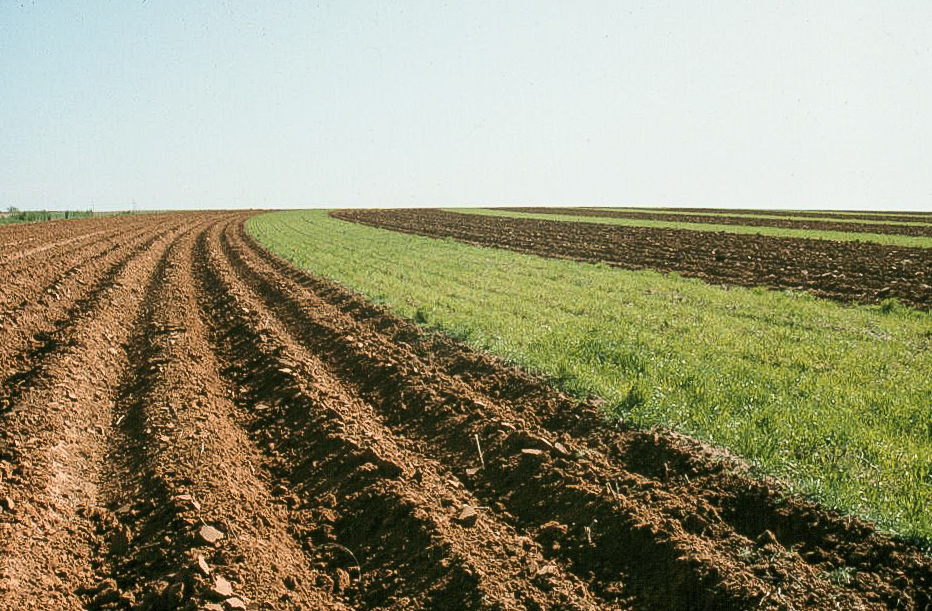4 Conservation Practices for Farmland
Colby Moorberg; Matthew Brungardt; Ryan Burns; Elliott Carver; Laura Starr; Mackenzie Tynon; Chris Weber; and August Williams
Abbreviations
PDF – Portable Document Format
SARE – Sustainable Agriculture Research and Extension
SWCS – Soil and Water Conservation Society
URL – Uniform Resource Locator
US – United States
USDA – US Department of Agriculture
Contour Buffer and Prairie Strips
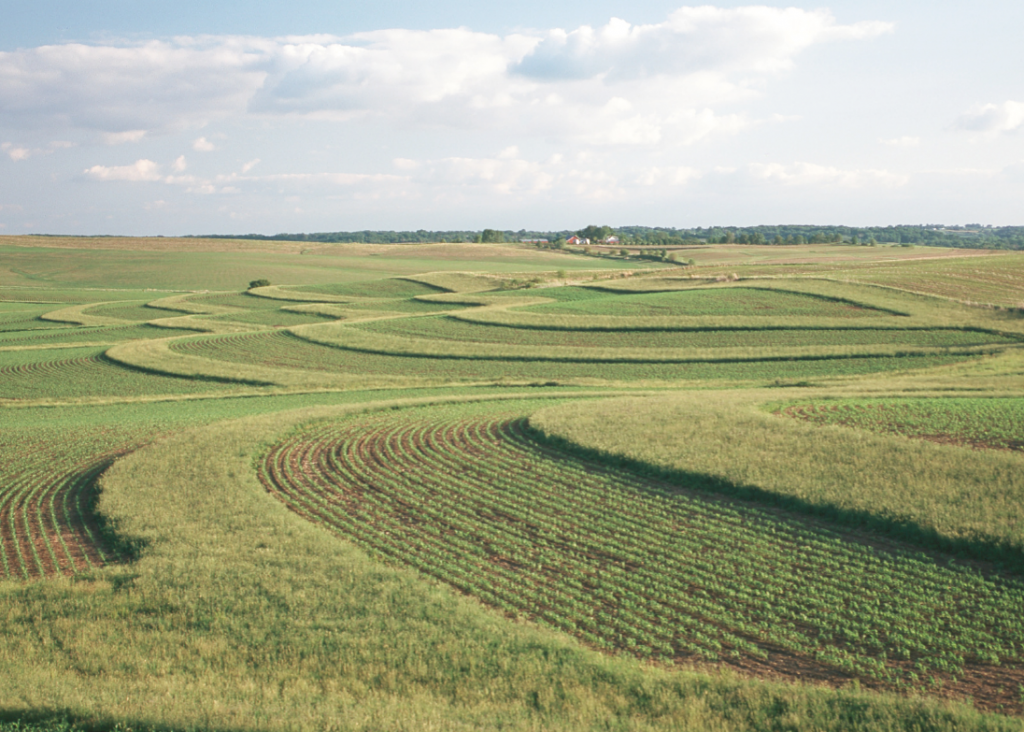
de Kok-Mercado, O. 2019. Science-Based Trials of Rowcrops Integrated with Prairie Strips. https://www.nrem.iastate.edu/research/STRIPS/.
This website from Iowa State University describes the use of prairie strips planted using native species along contours in row crop fields. It features links to additional information, frequently asked questions, and a short video on prairie strips.
SWCS Events. 2018. Prairie Strips: Build Benefits Naturally. Ankeny, IA: SWCS. https://vimeo.com/291571298.
This three-minute video from the SWCS advocates prairie strips and features a personal anecdote from Larry Stone, a corn and soybean farmer in Iowa; Tim Youngquist, an Agricultural Specialist II from Iowa State University; and Lance Koch from the USFWS. In the video, the participants recommend dedicating 10% of the area of a farm to prairie strips. The effects on wildlife like pheasants and butterflies is briefly mentioned.
USDA NRCS. 2014. Contour Buffer Strips. Conservation Practice Standard 332. 4. Washington, D.C.: USDA. https://www.nrcs.usda.gov/sites/default/files/2022-09/Contour_Buffer_Strips_332_CPS_9-14.pdf.
This conservation standard from the USDA NRCS defines contour buffer strips as narrow strips of permanent vegetative soil cover established along the contours of a hill slope, alternating with cropped strips farmed on the contour. The standard describes the purpose of this conservation practice, outlines conditions where the practice would apply, criteria for the practice, and some general considerations. It also briefly covers operation and maintenance of contour buffer strips. The URL offers a direct download of a PDF of this resource.
USDA NRCS. 2014b. Contour Buffer Strips. Conservation Practice Standard Overview 332. 1. Washington, D.C.: USDA. https://www.nrcs.usda.gov/sites/default/files/2022-09/Contour_Buffer_Strips_332_Overview.pdf.
This conservation practice standard overview for contour buffer strips from the USDA NRCS defines the practice. It also provides concise information about the practice. Commonly associated practices listed in this overview include grassed waterways; integrated pest management; residue and tillage management, no-till, and reduced tillage. The URL offers a direct download of a PDF of this resource.
Contour Farming
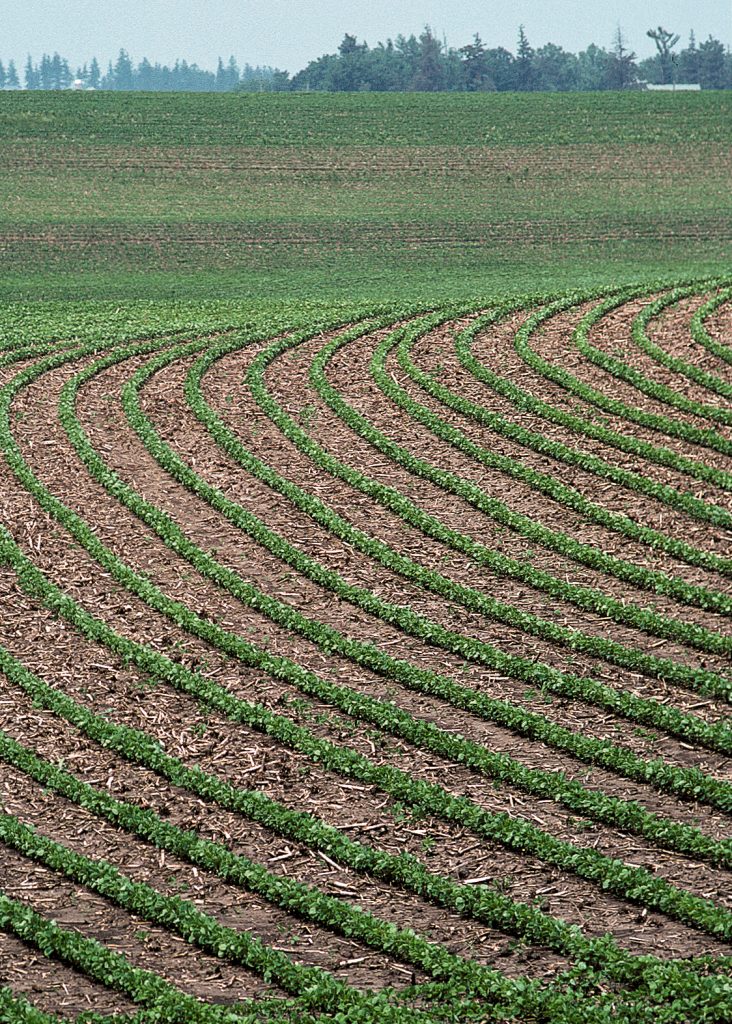
The Editors of Encyclopedia Britannica. 2016, February 16. Contour Farming. Encyclopedia Britannica, Inc. https://www.britannica.com/topic/contour-farming.
This encyclopedia article from Encyclopedia Britannica briefly describes contour farming and the history and benefits of the practice.
USDA NRCS. 2017b. Contour Farming. Conservation Practice Standard 330. 3. Washington, D.C.: USDA. https://www.nrcs.usda.gov/sites/default/files/2022-09/Contour_Farming_330_CPS_Oct_2017.pdf.
This conservation practice standard from the USDA NRCS defines contour farming as tillage, planting, and other operations aligned to the contour, creating roughness that alters the direction or velocity of water flow. The standard describes the purpose of the practice, general criteria for implementing the practice, considerations and other useful information. The URL offers a direct download of a PDF of this resource.
USDA NRCS. 2017a. Contour Farming. Conservation Practice Standard Overview 330. 1. Washington, D.C.: USDA. https://www.nrcs.usda.gov/sites/default/files/2022-09/Contour_Farming_330_Overview_Oct_2017.pdf.
This USDA NRCS overview of conservation practices provides a brief description and general information about contour farming. It contains a photograph of contour farming and a list of associated conservation practices, including grassed waterways, water and sediment control basins, and underground outlets. The URL leads to a direct download of a PDF of this publication.
Van Vlack, C. H., and L. E. Clapp. 1940. Contour Farming for Soil and Water Conservation. Bulletin P 1(11):1. https://lib.dr.iastate.edu/bulletinp/vol1/iss11/1/.
This historic extension bulletin from Iowa State University outlines the basics of contour farming. The bulletin outlines the effects of terracing, strip cropping, and contour farming on labor and fuel requirements, operating over terraces, and laying out guidelines for establishing contours.
Cover Crops

Clark, A., ed. 2007. Managing Cover Crops Profitably. 3rd Edition. College Park, MD: SARE Program. https://www.sare.org/Learning-Center/Books/Managing-Cover-Crops-Profitably-3rd-Edition/Text-Version.
This book, produced by SARE, provides in-depth information for nearly all aspects of cover crops as a conservation practice. Readers can navigate to an online version of each chapter in the book using the links on the left side of the screen. A printable PDF version of the book is also available. This book includes chapters on cover crop selection, rotations, soil fertility, pests, and more. Producer profiles are used throughout the book to provide real world scenarios and case studies for implementing cover crop in a production system. The book was designed to be a thorough resource, but not all encompassing, as was acknowledged in the foreword of the book.
Clark, A. 2019. Cover Crop Topic Room. https://www.sare.org/Learning-Center/Topic-Rooms/Cover-Crops.
This website from SARE and the companion extension bulletin to the website (accessible through a link on the site) provide a thorough overview of cover cropping. Clark begins by defining cover crops as plants used to improve soil health, prevent erosion, enhance water availability, and more. Clark also discusses cover crop selection, management considerations, crop rotations, no-till farming, organic farming, economics, soil fertility, water management, pest management, and pollinators. The site features many hyperlinks for key topics, making it an excellent starting point for further reading on cover crops.
SWCS Events. 2018. Cover Crops: Improving Soils for Productivity and Profitability. Ankeny, IA: SWCS. https://vimeo.com/290520999.
This video from the Soil and Water Conservation Society features Doug Peterson, a soil health specialist with the USDA NRCS, along with testimonials from three different Iowa farmers who have implemented cover crops and no-till on their farms. The video focuses on the positives of cover crops and includes testimonies that highlight the positive effects that cover crops have had on farmers’ lands.
USDA NRCS. 2014b. Cover Crop. Conservation Practice Standard 340. 1. Washington, D.C.: USDA. https://www.nrcs.usda.gov/sites/default/files/2022-09/Cover_Crop_340_CPS.pdf.
This conservation practice standard from the USDA NRCS defines cover crops as legumes, grasses, and forbs planted to maintain seasonal vegetative cover. Cover crops are identified that reduce soil erosion, increase organic matter and soil health, improve water quality, suppress weeds, improve soil moisture use, and minimize soil compaction. The standard provides criteria and considerations for implementing cover crops, information for developing plans and specifications, and recommendations for operation and maintenance. The URL has a link for a direct download of a PDF of this resource.
USDA NRCS. 2014a. Cover Crop. Conservation Practice Standard Overview 340. 4. Washington, D.C.: USDA. https://www.nrcs.usda.gov/sites/default/files/2022-09/Cover_Crop_340_Overview.pdf.
This conservation practice standard overview from the USDA NRCS begins with a definition of cover crops, followed by a brief description of the conservation practice. It concludes with a list of practices commonly associated with cover crops, including conservation crop rotation, residue and tillage management, nutrient management, and integrated pest management. The URL provides a direct link for a PDF of this resource.
Cross Wind Trap Strips
USDA NRCS. 2005. Cross Wind Trap Strips. Conservation Practice Standard 589C. 3. Washington, D.C.: USDA. https://www.nrcs.usda.gov/sites/default/files/2023-08/589_NHCP_CPS_Cross_Wind_Trap_Strips_2023.pdf.
This conservation practice standard from the USDA NRCS defines cross wind trap strips as herbaceous cover established in strips perpendicular to the most erosive wind events. The standard provides information on where the practice applies, criteria for implementing the practice, general considerations, and plans and specifications. The URL leads to a direct download of a PDF.
USDA NRCS. 2014. Cross Wind Trap Strips. Conservation Practice Standard Overview 589C. 1. Washington, D.C.: USDA. https://www.nrcs.usda.gov/sites/default/files/2023-08/589_NHCP_PO_Cross_Wind_Trap_Strips_2023.pdf.
This conservation practice overview from the USDA NRCS defines cross wind trap strips and briefly provides information about the conservation practice. It also lists commonly associated conservation practices. The URL leads to a direct download of a PDF.
Emergency Tillage
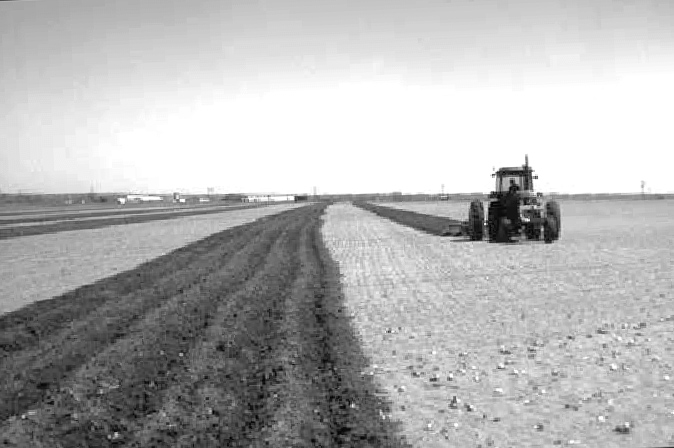
Presley, D., E. Brokesh, P. Tomlinson, and J. Tatarko. 2013. Emergency Wind Erosion Control. MF2206. 4. Manhattan, KS: Kansas State University Agricultural Experiment Station and Cooperative Extension Service. https://www.bookstore.ksre.k-state.edu/Item.aspx?catId=364&pubId=763.
This extension bulletin from Kansas State University provides a broad overview of emergency wind erosion control. It includes five tips for effective emergency tillage and information related to emergency tillage using mulching, emergency tillage in sandy soils, spacing of tillage operations, and more.
USDA NRCS. 2014a. Surface Roughening. Conservation Practice Standard 609. 2. Washington, D.C.: USDA. https://www.nrcs.usda.gov/sites/default/files/2022-10/Surface_Roughening_609_CPS.pdf.
This USDA NRCS conservation practice standard defines surface roughening as tillage operations that create random roughness on the soil surface. It describes conditions that allow wind erosion and describes how emergency tillage works as well as how to correctly implement surface roughening on a field. The URL leads to a direct download of a PDF.
USDA NRCS. 2014b. Surface Roughening. Conservation Practice Standard Overview 609. 1. Washington, D.C.: USDA. https://www.nrcs.usda.gov/sites/default/files/2022-10/Surface_Roughening_609_PO.pdf.
This USDA NRCS conservation practice standard overview concisely describes surface roughening. It includes a picture of the practice and a list of associated conservation practices, which include reduced till, cross wind ridges, cross wind trap strips, herbaceous barriers, and establishing windbreak/shelterbelt. The URL leads to a direct download of a PDF.
USDA NRCS. 2017a. Crosswind Ridges. Conservation Practice Standard 588. 2. Washington, D.C.: USDA. https://www.nrcs.usda.gov/sites/default/files/2022-09/Cross_Wind_Ridges_588_CPS_Oct_2017.pdf.
This USDA NRCS conservation practice standard defines crosswind ridges as a surface roughening practice in which ridges are formed from normal tillage, planting, and other operations in which ridges are aligned perpendicular to the prevailing wind. It provides general criteria for the practice, and what should considered when implementing the practice. The URL leads to a direct download of a PDF.
USDA NRCS. 2017b. Crosswind Ridges. Conservation Practice Standard Overview 588. 1. Washington, D.C.: USDA. https://www.nrcs.usda.gov/sites/default/files/2022-09/Cross_Wind_Ridges_588_Overview_Oct_2017.pdf.
This USDA NRCS conservation practice standard overview provides a concise description of crosswind ridges with a picture and a list of associated conservation practices like conservation crop rotations, cover crop, and residue and tillage management. The URL leads to a direct download of a PDF.
Grassed Waterway
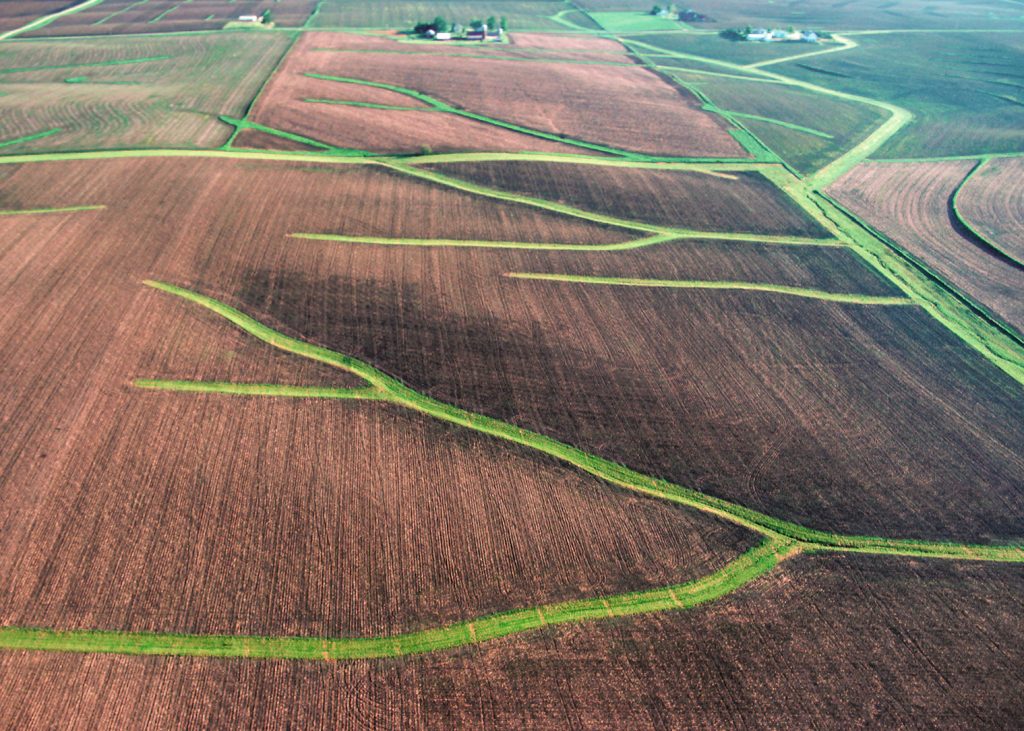
Ampim, P. A. Y., and F. Jaber. 10/11. Improving Water Quality with Grassed Waterways. 6. College Station, TX: Texas A&M AgriLife Extension Service. https://cdn-ext.agnet.tamu.edu/wp-content/uploads/2019/03/EL-5532_-Improving-Water-Quality-with-Grassed-Waterways.pdf.
This extension bulletin from Texas A&M University provides a brief overview of grassed waterways with a general description and information for planning, designing, and maintaining grassed waterways. The URL leads to a direct download of a PDF.
McVay, K. A., G. M. Powell, and R. Lamond. 2004. Maintaining Grassed Waterways. 4. Manhattan, KS: Kansas State University Agricultural Experiment Station and Cooperative Extension Service. https://www.bookstore.ksre.ksu.edu/Item.aspx?catId=226&pubId=550.
This extension bulletin from Kansas State University outlines how to maintain already installed grassed waterways in the landscape. It begins with a general description of grassed waterways and details variations in design, selecting grasses, fertilizing and liming, inspections and maintenance, and managing for forage production and habitat.
USDA NRCS. 2007. Chapter 7 Grassed Waterways. In Engineering Field Handbook, 166. Washington, D.C.: USDA NRCS. https://directives.sc.egov.usda.gov/OpenNonWebContent.aspx?content=17766.wba.
This chapter from the USDA NRCS Engineering Field Handbook provides extensive technical details on the standard design and engineering considerations for grassed waterways. The chapter includes information on assessing the suitability of a site for grassed waterways, planning and design considerations, the design process, sizing channels, layout and construction, and maintaining grassed waterways. The URL leads to a direct download of a PDF.
USDA NRCS. 2014. Grassed Waterway. Conservation Practice Standard 550. 4. Washington, D.C.: USDA. https://www.nrcs.usda.gov/sites/default/files/2022-09/Grassed_Waterway_412_CPS_9_2020.pdf.
This practice standard defines grassed waterways as broad, shallow channels established with suitable vegetation to move surface water at non-erosive velocities to a stable outlet. It identifies criteria necessary for constructing and maintaining a grassed waterway and describes what else to take into account when installing a grassed waterway. The URL leads to a direct download of a PDF.
USDA NRCS. 2014. Grassed Waterway. Conservation Practice Standard Overview 550. 1. Washington, D.C.: USDA. https://www.nrcs.usda.gov/sites/default/files/2022-09/Grassed_Waterway_412_Overview_9_2020.pdf.
This conservation practice overview provides a brief description of grassed waterways. General information about the practice is provided, along with a list of commonly associated conservation practices. The URL leads to a direct download of a PDF.
Residue Management and Tillage Practices

Al-Kaisi, M., M. Hanna, and M. Duffy. 2009. Considerations in Selecting No-Till — Resource Conservation Practices. 6. Ames, Iowa: Iowa State University. https://store.extension.iastate.edu/product/Considerations-in-Selecting-No-Till-Resource-Conservation-Practices.
This extension publication provides insights into what should influence selecting no-till as an agricultural management practice. This bulletin highlights the effect of implementing a no-till system on crop yields, as well as notable management considerations like weed control, residue management, and equipment requirements. The authors suggest that, in most cases, converting from conventional tillage to no-till can be achieved without negatively affecting economic returns.

Buchholz, D. D., E. Palm, G. Thomas, and D. L. Pfost. 1993, October. No-Till Planting Systems. https://extension2.missouri.edu/g4080.
This extension bulletin and webpage outline the advantages and disadvantages of a no-till system, highlighting other management decisions like field selection, fertility, crop residue, machinery, and pest control. Selecting machinery and managing pests is reviewed; these are areas typically require the most adjustment in implementing no-till.
DeJong-Hughes, J., and A. Daigh. 2018. Reducing Tillage Intensity. https://extension.umn.edu/soil-management-and-health/reducing-tillage-intensity.
This extension website outlines the benefits of reducing tillage and addresses some of the most common challenges (weed persistence, cost, and social perceptions). It describes different tillage methods and introduces some joint research conducted by the University of Minnesota and North Dakota State University. The research presented describes how tillage affects soil temperature, residue cover, and soil moisture. The results of two other research projects are show reduced tillage (strip-till in the examples) reduces the amount of soil organic carbon lost. This publication introduces important soil concepts for tillage and presents research results relevant to producers.
Idowu, J., S. Angadi, M. Darapuneni, and R. Ghimire. 2017. Reducing Tillage in Arid and Semi-Arid Cropping Systems: A Case Overview. Las Cruces: New Mexico State University. https://aces.nmsu.edu/pubs/_a/A152/welcome.html.
This extension bulletin describes the potential benefits of reduced tillage in the semi-arid and arid regions of New Mexico. The bulletin briefly defines tillage operations and the benefits of reducing tillage: controlling erosion, conserving soil moisture, and accumulating soil organic matter. The bulletin is an overview of how tillage affects semi-arid and arid environments and the mechanisms by which reducing tillage improves soil conditions and reduces erosion. This resource offers a short summary of some agronomic and economic research specific to environments like the southwestern US.

USDA NRCS. 2016a. Residue and Tillage Management, No Till. Conservation Practice Standard Overview 329. 1. Washington, D.C.: USDA. https://www.nrcs.usda.gov/sites/default/files/2022-09/Residue_And_Tillage_Management_No_Till_329_PO_Sep_2016_0.pdf.
This USDA NRCS conservation practice standard overview defines residue and tillage management: no-till/strip till/direct seed as practices that target the amount, orientation, and distribution of crop residue that remains on the soil surface year round. It includes an image of soybean seedlings growing through the residue of the previous crop. The overview also includes a brief summary of general information about when the practice is used, benefits of no-till management, and operation and maintenance considerations. A list of common associated practices is included covering conservation crop rotation, nutrient management, pest management, and irrigation water management. The URL leads to a direct download of a PDF.
USDA NRCS. 2016b. Residue and Tillage Management, Reduced Till. Conservation Practice Standard Overview 345. 1. Washington, D.C.: USDA. https://www.nrcs.usda.gov/sites/default/files/2022-09/Residue_And_Tillage_Management_Reduced_Till_345_PS_Sept_2016.pdf.
This conservation practice standard overview defines reduced tillage, or “mulch till” as a practice that manages distribution, orientation, and amount of residue on the soil surface all year with limited soil disturbance to produce crops. The publication provides brief information about the practice, describes the benefits of the practice, and lists commonly associated conservation practices. Associated practices include conservation crop rotation, nutrient management, pest management, and irrigation water management. The URL leads to a direct download of a PDF.
USDA NRCS. 2016c. Residue Management, Reduced Till. Conservation Practice Standard 345. 4. Washington, D.C.: USDA. https://www.nrcs.usda.gov/sites/default/files/2022-09/Residue_And_Tillage_Management_Reduced_Till_345_CPS.pdf.
This USDA NRCS conservation practice standard defines residue and tillage management in reduced till. Reduced till is defined as managing the crop or other plant residue on the soil surface year-round while also limiting soil disturbance from crop production. The standard describes the purpose of reduced tillage and sets minimum criteria that must be met when implementing reduced till as a conservation practice. The standard also outlines general considerations, details for plans and specifications, and considerations for operation and maintenance. The URL leads to a direct download of a PDF.
USDA NRCS. 2016d. Residue and Tillage Management, No Till. Conservation Practice Standard 329. 4. Washington, D.C.: USDA. https://www.nrcs.usda.gov/sites/default/files/2022-09/Residue_And_Tillage_Management_No_Till_329_CPS_0.pdf.
This conservation practice standard defines no till as limiting soil disturbance while managing the distribution, orientation, and amount of plant residue on the soil surface year-round. It describes why and where no till management is implemented. The standard describes the purpose of no till and provides the minimum criteria for implementing the conservation practice. The standard also describes general considerations for the practice, soil health and organic matter content, increasing plant-available moisture, wildlife food and cover, plans and specifications, and operation and maintenance. The URL leads to a direct download of a PDF.
Stripcropping

USDA NRCS. 2017a. Stripcropping. Conservation Practice Standard 585. 4. Washington, D.C.: USDA. https://www.nrcs.usda.gov/sites/default/files/2022-10/Stripcropping_585_CPS_Oct_2017.pdf.
This conservation practice standard from the USDA NRCS defines stripcropping as growing rotations of erosion-susceptible and erosion-resistant crops or fallow systematically in strips across a field. This reduces rill and sheet erosion from water and wind erosion, as well as reduces movement of nutrients, sediment, and pesticides. The standard lists criteria for implementing the practice on farmland, general considerations, information related to plans and specifications, and operation and maintenance information. The URL leads to a direct download of a PDF.
USDA NRCS. 2017b. Stripcropping. Conservation Practice Standard Overview 585. 1. Washington, D.C.: USDA. https://www.nrcs.usda.gov/sites/default/files/2022-10/Stripcropping_Overview_585_Oct_2017_final.pdf.
This NRCS conservation practice overview defines stripcropping as systematically growing crops in strips in a field to reduce soil erosion. The overview includes a brief summary of information about the practice and a list of commonly associated conservation practices, including conservation crop rotation, cover crop, residue and tillage management, nutrient management, and integrated pest management. The URL leads to a direct download of a PDF.
Terraces
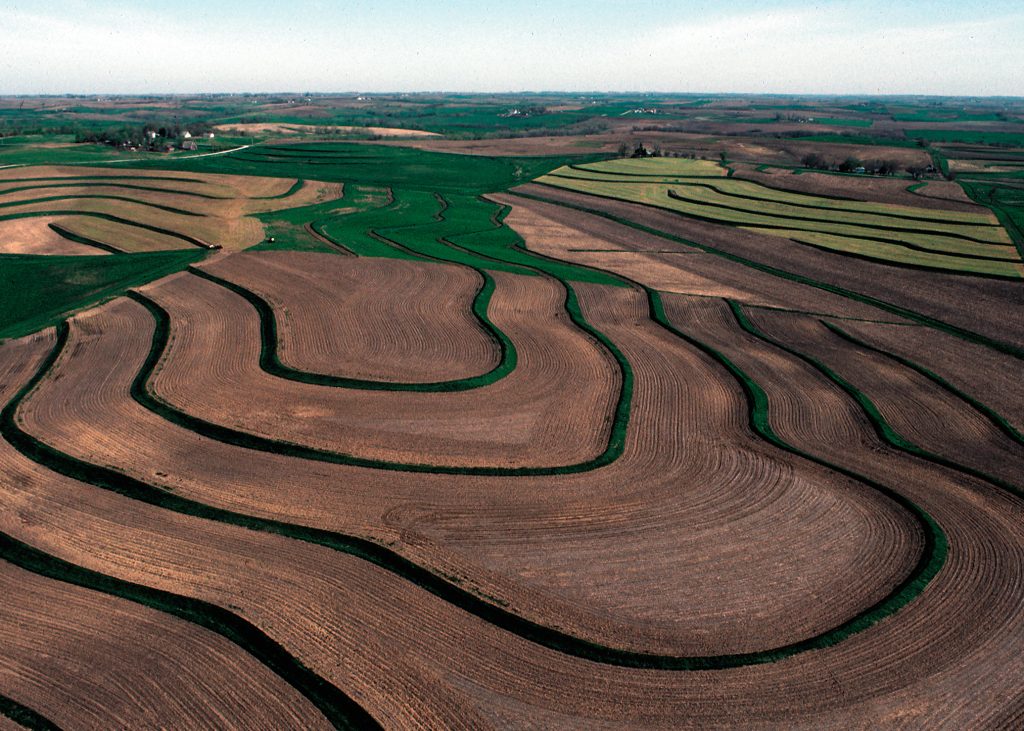
USDA NRCS. 1990. Farming and Maintaining Terraces. 20. Washington, D.C.: USDA. https://nrcspad.sc.egov.usda.gov/DistributionCenter/product.aspx?ProductID=131.
This booklet from the NRCS uses pictures, figures, and text to show terraces as an effective conservation practice. It covers the different types of terraces (broadbase, steep-backslope, and narrow-base), related conservation practices, information for farming terraced land, and maintenance of terraces.
USDA NRCS. 2014a. Terraces. Conservation Practice Standard 600. 2. Washington, D.C.: USDA. https://www.nrcs.usda.gov/sites/default/files/2023-08/600_NHCP_CPS_Terrace_2023.pdf.
This conservation practice standard from the USDA NRCS defines terraces as combinations of a ridge and channel, or earth embankments, constructed across a field slope. The purpose is to reduce erosion, trap sediment, and retain runoff for soil moisture conservation. The standard outlines conditions where the practice applies, criteria, considerations, information for plans and specifications, and information for operation and maintenance. The URL leads to a direct download of a PDF.
USDA NRCS. 2014b. Terraces. Conservation Practice Standard Overview. 1. Washington, D.C.: USDA. https://www.nrcs.usda.gov/sites/default/files/2022-10/Terrace_600_Overview_9_2020.pdf.
This conservation practice overview defines terraces as combinations of a ridge and channel, or earth embankments, constructed across a field slope, and general information about the conservation practice. The overview also lists commonly associated conservation practices, including grassed waterways, underground outlets, and subsurface drains. The URL leads to a direct download of a PDF.
USDA NRCS. 2017. Chapter 8 Terraces. In Engineering Field Handbook, 99. Washington, D.C.: USDA NRCS. https://directives.sc.egov.usda.gov/31181.wba.
This chapter from the USDA NRCS Engineering Field Handbook provides in-depth details on the design, construction, use, and maintenance of terraces. In addition, planning considerations are provided, along with definitions of nomenclature. Detailed information is provided for the various types of terrace cross sections, terrace alignment and spacing, and terrace channels and outlets. The three primary types of terraces described are broadbase, steep-backslope, and narrow-base terraces. Useful photos, figures, and engineering schematics are provided throughout the chapter. The URL leads to a direct download of a PDF.
Windbreaks and Shelterbelts

USDA NRCS. 2022. Windbreak Renovation. YouTube. https://www.youtube.com/watch?v=EUoMCc3J4dA.
The video below from the USDA NRCS provides an overview of windbreak renovation. It features farmers Frank and Jaci Mills from Crawford, Nebraska and the windbreak they are renovating. Benefits of windbreaks are summarized.
USDA NRCS. 2021. Windbreak/Shelterbelt Establishment and Renovation. Conservation Practice Standard 650. 7. Washington, D.C.: USDA. https://www.nrcs.usda.gov/sites/default/files/2022-10/Windbreak-Shelterbelt_Establishment_380_NHCP_CPS_2021.pdf.
This USDA NRCS conservation practice standard defines windbreaks as single or several rows of trees or shrubs in linear configurations perpendicular to the predominant wind direction. Benefits of windbreaks include reducing soil wind erosion, protecting plants from potential wind damage, improving the soil microenvironment for increased plant yield, managing snowfall dispersion, and improving irrigation efficiency. The conservation practice standard outlines windbreak establishment as well as the renovation of windbreaks through removing, replacing, or releasing trees and shrubs from an existing windbreak or shelterbelt, or adding or removing rows from a windbreak or shelterbelt, or removing branches from trees and shrubs. For existing windbreaks, this may entail replacing an existing windbreak, removing selected trees, adding rows, or removing selected branches of trees or shrubs. The standard describes the purpose and provides criteria for applying windbreaks and shelterbelts. Considerations for implementing the practices are also described. The URL leads to a direct download of a PDF.
USDA NRCS. 2012. Windbreak/Shelterbelt Establishment (380) or Renovation (650). Conservation Practice Standard Overview 380. 1. Washington, D.C.: USDA. https://www.nrcs.usda.gov/Internet/FSE_DOCUMENTS/stelprdb1255014.pdf.
This conservation standard practice overview from the USDA NRCS defines windbreak/shelterbelt as planting one or several rows of trees or shrubs in linear configurations aligned perpendicular to the predominant wind direction. The overview includes information about the conservation practice and a list of commonly associated conservation practices, which includes conservation crop rotation, cover crop, residue management, tree/shrub site preparation, tree/shrub establishment, tree/shrub pruning, and upland wildlife habitat management. The URL leads to a direct download of a PDF.
Wright, B., and R. Straight. 2019. Chapter 6 Windbreaks. In Training Manual for Applied Agroforestry Practices, 2018 Edition, 92–113. Columbia, MO: University of Missouri Center for Agroforestry. http://centerforagroforestry.org/pubs/training/index.php.
This book chapter the University of Missouri Center for Agroforestry presents training on windbreaks for foresters, farmers, and conservationists. It is thorough and covers windbreak function, benefits, design, site preparation, planting, and maintenance. It also includes an anecdote describing the successful experience of a Nebraska farmer using windbreaks in his operation. Another section outlines the economics of windbreaks. The chapter includes a list of additional resources and has a review exercise at the end to assess reader understanding, complete with answers to the exercises.

